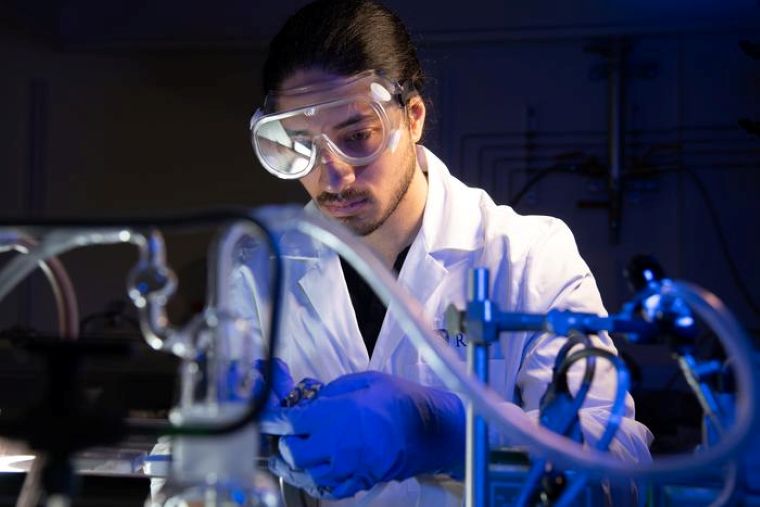An international team of researchers says they have successfully integrated a pair of “fundamentally different” two-dimensional materials into a third, all-new 2D material with exotic properties called “glaphene.”
The new, chemically integrated hybrid material, developed by a team led by Rice University materials scientists, combines two-dimensional graphene, a sheet of carbon atoms arranged in a hexagonal lattice that acts as a conductor, with two-dimensional silica glass, an insulator.
Unlike previous efforts that involved stacking different two-dimensional materials to exploit the exotic properties of both, the new method chemically bonded the layers together, resulting in a novel material with unique electrical and conductive properties inherited from its component materials.
“The layers do not just rest on each other, electrons move and form new interactions and vibration states, giving rise to properties neither material has on its own,” said Sathvik Iyengar, a doctoral student at Rice and a first author on the study detailing the team’s findings. “This was not something only one lab could do. This research was a cross-continental effort to create and understand a material nature does not make on its own.”
Creating 2D Material Glaphene With Exotic Properties of Other 2d Materials
Since the creation of the first laboratory-made graphene, scientists have been fascinated with its unique electrical, photonic, and conductive properties. Several new 2D materials have also shown unusual properties like electromagnetism and superconductivity (under the right conditions), but combining the materials to take advantage of the properties of each material for novel electronics applications has proven challenging.
The most common method of combining one 2D material with another involves stacking them like sheets of paper. Due to their unusual material properties, these sheets are typically held together without any added adhesive by weak van der Waals forces that offer little more adhesion than a refrigerator magnet.
The Rice University team wondered if a different approach might allow for a stronger bonding of disparate 2D materials that retain some, or all, of the unusual properties of each that make them potentially valuable in exotic electronics applications like 3D holograms, quantum computers, and advanced AI systems. Ultimately, they decided to explore chemically bonding the two materials, which should be much stronger than a weak van der Waals bond.
A True Hybrid with New Electronic and Structural Properties
After some experimentation, the team developed a two-step, single reaction process to create their hybrid glaphene. This involved several months working with Anchal Srivastava, a visiting professor from Banaras Hindu University in India, to create a customized, high-temperature, low-pressure apparatus.
After loading the apparatus with a liquid chemical precursor containing both silicon and carbon, the team started the reaction. By manually tuning the oxygen levels within the setup, the Rice University team coaxed the precursor to grow graphene. For the second step, the team tuned the conditions inside the apparatus to favor the formation of a 2D silica layer.
The result was a two-dimensional material made of graphene and silica bonded at the chemical layer. Unlike stacked 2D materials, the team says the bond of its newly minted glaphene was much stronger, “allowing electrons to flow between them and giving rise to entirely new behaviors.”
“That setup was what made the synthesis possible,” Iyengar said. “The resulting material is a true hybrid with new electronic and structural properties.”
“Mixing Ideas That Others Hesitate to Mix”
After successfully creating glaphene, the Rice team reached out to Manoj Tripathi and Alan Dalton at the University of Sussex to confirm its chemical structure. That test also found some unusual atomic vibrational readings. However, Marcos Pimenta, an expert in spectroscopy based in Brazil, helped Iyengar determine it was an instrument artifact and not a novel vibration. Still, the process did confirm the material’s unique chemically bonded atoms of graphene and silica, making it a whole new material.
To verify their experimental results against quantum simulations of the behavior of bonded 2D glaphene layers at the atomic level, the team collaborated with Vincent Meunier at Pennsylvania State University. According to Meunier, a closer analysis of the laboratory-made glaphene found that the graphene and silica layers were bonded in a novel way, allowing them to partially share electrons across the interface.
In effect, the team turned a metal (graphene) and an insulator (silica) into an entirely new type of hybrid semiconductor that does not currently exist. Iyengar said this successful hybridization of 2D materials opens the door to creating entirely new classes of 2D materials with exotic properties, such as metals with insulators or magnets with semiconductors, “to create custom-built materials from the ground up.”
“Since I started my Ph.D., my adviser has encouraged me to explore mixing ideas that others hesitate to mix,” Iyengar said.
“Professor Ajayan has also said that true innovation happens at the junctions of hesitation,” he added, “and this project is proof of that.”
Christopher Plain is a Science Fiction and Fantasy novelist and Head Science Writer at The Debrief. Follow and connect with him on X, learn about his books at plainfiction.com, or email him directly at christopher@thedebrief.org.

